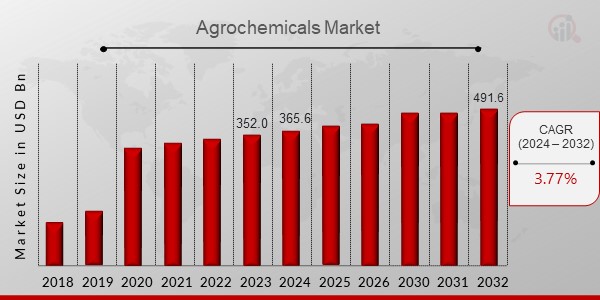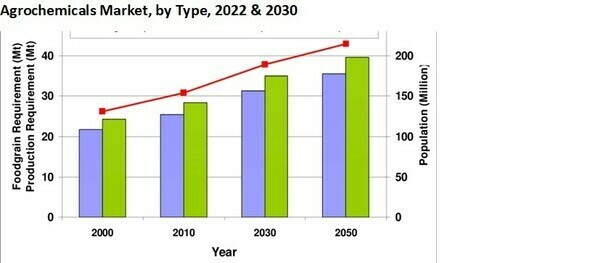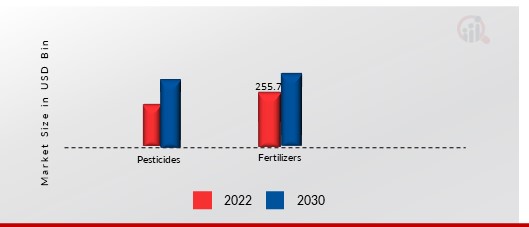Agrochemicals Market Overview
Agrochemicals Market Size was valued at USD 352.06 billion in 2023. The Agrochemicals market industry is projected to grow from USD 365.60 Billion in 2024 to USD 491.69 billion by 2032, exhibiting a compound annual growth rate (CAGR) of 3.77% during the forecast period (2024 - 2032). Rising demand for fertilizers and the growing need for crop protection are the key market drivers enhancing market growth.

Source: Secondary Research, Primary Research, MRFR Database and Analyst Review
Agrochemicals Market Trends
- Growing demand for food owing to the rising population to boost the market growth
Consumption patterns are changing as a result of the increasing population and wealth around the world. Along with increasing production to meet demand, there is a need to care for the nutritional requirements of an increasingly affluent population. For instance, the IMF estimates that India will have a population of 1.39 billion in 2021. According to FAO, severe food insecurity will affect 11.7% of the world's population in 2021. Waste is caused by shrinking arable land and crops lost to pest attacks, a major obstacle to ensuring food and nutritional security. The US Department of Agriculture reports that since 2000, the total amount of land used for farming in the US has decreased yearly. As of 2021, there were 895.3 million acres of farmland worldwide, a drop of nearly 50 million. These elements drive up the demand for agrochemicals, increasing agricultural productivity.
Figure 1: Agrochemicals Market, by Type, 2022 & 2030 (USD Million)

Source: Secondary Research, Primary Research, MRFR Database and Analyst Review
Moreover, governments, especially in Asian countries, are taking government initiatives to support farmers by initiating several programs. For instance, the Indian government places a high priority on farmer welfare and is enacting a number of farmer's welfare programs to boost the agricultural sector and enhance farmers' economic circumstances. The government has rolled out several new initiatives like Neem Coated Urea, Soil Health Card Scheme, Paramparagat Krishi Vikas Yojana (PKVY), Pradhan Mantri Fasal Bima Yojana (PMFBY)National Agriculture Market (e-NAM), Pradhan Mantri Krishi Sinchayee Yojana (PMKSY), and Interest Subvention Scheme. All farmers will benefit from these programs. Further, the Australian government is helping the agriculture sector reach its target of $100 billion in production by 2030. This is another factor driving the growth of the Agrochemicals market revenue.
Additionally, it is anticipated that the expanding animal husbandry and animal feed industries will favorably affect the expansion of the world agrochemicals market. The largest feed industry in the world is found in the United States. The American Feed Industry Association (AFIA) estimates that in 2020, the U.S. exported 32.4 thousand tons of animal feed at a value of USD 13 billion. Thus, this has enhanced the Agrochemicals market CAGR globally.
News :
In April 2024, the Ministry of the Environment granted final approval for the experimental cultivation of a specific type of rice in open fields using advanced genomic techniques called as TEA, or assisted evolution techniques, in Italy. This rice variety possesses inherent resistance to the Pyricularia oryzae fungus, commonly referred to as "brusone" or rice blast fungus. It is capable of withstanding the attacks of this fungal pathogen without the need for fungicides. Rice blast fungus is a highly detrimental disease that can cause significant production losses, sometimes up to 50%, in certain years. The University of Milan submitted a request for clearance to conduct experiments on plants generated via genome editing or cisgenesis, in accordance with the regulations governing field trials. The laboratory studies utilizing resistance testing have yielded outstanding outcomes in terms of productivity, all without the application of agrochemicals.
In March 2023, the governments of Ecuador, India, Kenya, Laos, Philippines, Uruguay, and Vietnam have collaborated to initiate a $379 million effort aimed at addressing pollution caused by the utilization of pesticides and plastics in agriculture. Chemicals are essential in agriculture, with over 4 billion kg of insecticides and 12 billion kg of agricultural plastics being utilized annually. Although these compounds have advantages in increasing food production, they also provide substantial hazards to human health and the environment.
Up to 11,000 individuals perish each year owing to the poisonous properties of pesticides, and the presence of chemical remnants can harm ecosystems, reducing the fertility of soil and the ability of farmers to adapt to climate change. The incineration of agricultural plastics during their initial disposal further exacerbates a global air pollution emergency, resulting in one out of every nine fatalities worldwide. Toxic persistent organic pollutants (POPs) are released into the environment by very hazardous pesticides and mismanaged agricultural plastics. These chemicals do not degrade and instead contaminate the air, water, and food. The cost of these inputs is typically lower than that of sustainable alternatives, which provides farmers with minimal motivation to embrace more effective methods.
Agrochemicals Market Segment Insights
Agrochemicals Type Insights
The Agrochemicals market segmentation, based on type, includes pesticides and fertilizers. The fertilizers segment held the majority share in 2022, contributing to around ~65-67% of the Agrochemicals market revenue. The high consumption of fertilizers is driving the agrochemicals market to increase crop production. There are three different ways to fertilize grains and cereals. These fertilizers can be sprayed, top-dressed separately, or mixed with other fertilizers and applied to seedlings. To increase cereal and grain yields, fertilizers must be applied at the correct rate and in the right amount. Farmers are using more fertilizers to increase the productivity and yield of different crops because the increased food demand is placing additional strain on agricultural land.
March 2022 : The U.S. Department of Agriculture (USDA) has announced it will support additional fertilizer production for American farmers. This summer, the USDA will make USD 250 million available through a new grant program to support American farmers' independent, creative, and sustainable fertilizer production. Additionally, the USDA will start a public inquiry to gather data about seeds and agricultural inputs, fertilizer, and retail markets to address growing concerns about competition in the agricultural supply chain.
October 2022 : Prime Minister Narendra Modi unveiled the "One Nation, One Fertilizer" initiative. The PM also launched the PM Kisan Samman Sammelan 2022 at the Indian Agricultural Research Institute and released PM-KISAN funds totaling Rs 16,000 crore through Direct Benefit Transfer.
Figure 2: Agrochemicals Market, by Type, 2022 & 2030 (USD billion)

Source: Secondary Research, Primary Research, MRFR Database and Analyst Review
Agrochemicals Product Type Insights
The Agrochemicals market segmentation, based on product type, includes potassic, nitrogenous, and phosphatic. The nitrogenous segment dominated the market in 2022 and is projected to be the faster-growing segment during the forecast period, 2022-2030. Three important cereal crops—rice, wheat, and maize—acquire about 60% of the world's nitrogen. Widely available nitrogen fertilizers aid in accelerating plant growth and boosting crop yields. But as nitrogenous fertilizers are used more frequently, the surrounding areas, particularly water bodies, suffer. This is propelling the market for agrochemicals, positively impacting the market growth.
Agrochemicals Crop Type Insights
The Agrochemicals market data has been bifurcated by crop type into food grains, cash crops, plantation crops, and horticulture crops. The food grains segment dominated the market in 2022 and is projected to be the faster-growing segment during the forecast period. The total demand is expected to rise at a rate of 2% per year in the medium term due to increased population, despite declining per capita direct consumption of food grains. Moreover, according to FAO, the amount of cereal produced worldwide in 2022 has increased by 8.3 million tonnes (0.3 percent) this month to 2 765 million tonnes, though it is still 1.7% less than last year. The majority of the increase is associated with wheat, as a result of upward revisions for Australia and the Russian Federation that increased the forecast for wheat production to 794 million tonnes and reinforced expectations for a record-high output in 2022.
Agrochemicals Regional Insights
By Region, the study provides market insights into North America, Europe, Asia-Pacific, and the Rest of the World. Asia Pacific agrochemicals market accounted for USD 154.3 billion in 2022 and is expected to exhibit a significant CAGR growth during the study period. The top regional market contributors include China, Japan, and India. According to the International Trade Center (ITC) and FAO, China is the world's largest manufacturer and exporter of pesticides. According to the Organization for Economic Co-operation and Development (OECD) and FAO, India is the fourth-largest producer of agrochemicals in the world, after China, Japan, and the United States. Moreover, the China Agrochemicals market held the largest market share, and the India Agrochemicals market was the fastest-growing market in the Asia-Pacific region.
Further, the major countries studied in the market report are: The U.S., Canada, Germany, France, the UK, Italy, Spain, China, Japan, India, Australia, South Korea, and Brazil.
Figure 3: Agrochemicals Market Share By Region 2022 (%)

Source: Secondary Research, Primary Research, MRFR Database and Analyst Review
Europe Agrochemicals market accounts for the third-largest market share. Agrochemicals are crucial for achieving high yields as they are essential for preventing pests and diseases in the field. Because more people are eating cereals and grains like rice, wheat, rye, corn, oats, sorghum, and barley, there is an increase in demand for fertilizers. This is expected to fuel the market in this Region. Further, the Germany Agrochemicals market held the largest market share, and the UK Agrochemicals market was the fastest-growing market in the European Region.
The North America agrochemicals Market is held the second largest market in 2022. Moreover, the U.S Agrochemicals market held the largest market share in 2022. The U.S. dominated the North American agrochemicals market due to the rising demand for commodities like blueberries, sorghum, soy, and maize. In addition, the United States is the world's largest producer of maize, sorghum, blueberries, and almonds.
Agrochemicals Key Market Players & Competitive Insights
The Major market players are increasing their spending on their R&D initiatives to increase their footprint in the market. Market participants also want to expand their presence by updating their market developments, such as new product launches, contractual agreements, mergers and acquisitions, increased investments, and collaboration with other organizations. Additionally, studies indicate that the market leaders in the Agrochemicals industry are expected to offer their products at a moderate price to further garner a more extensive consumer base.
One of the primary strategies the Agrochemicals Industry market leaders are undertaking is expanding their clients by manufacturing locally to reduce operating costs. During the forecast period, the Agrochemicals industry has provided various products reaping significant benefits. The Agrochemicals market major player such as The Mosaic Company (US), Bayer CropScience Limited (Germany), The Dow Chemical Company (US), BASF SE (Germany), Monsanto Company (US), Syngenta AG (Switzerland), Adama Agricultural Solutions Ltd (Israel), Nufarm Limited (Australia), Arysta Lifescience Corporation (Japan), and Crystal Crop Protection Pvt. Ltd. (India), and others are working on expanding the market demand by investing in research and development activities.
Crystal Crop Protection Pvt. Ltd. is an R&D-based crop protection manufacturing and marketing company. Crystal's products are designed to support the entire crop lifecycle from planting to harvesting. The business offers crop protection options to Indian farmers to help them increase productivity and profitability on their farms. In February 2022, Crystal Crop Protection Limited introduced its new product HOLA, a post-emergent herbicide to safeguard sugarcane crops nationwide from weeds.
Bayer Crop Science manufactures crop protection products like herbicides, insecticides, fungicides, and seed treatments. In January 2022, Bayer Crop Science introduced Ambition, a formulation of a crop supplement containing amino acids and fulvic acids in China.
Key Companies in the Agrochemicals market includes
- The Mosaic Company (US)
- Bayer CropScience Limited (Germany)
- The Dow Chemical Company (US)
- BASF SE (Germany)
- Monsanto Company (US)
- Syngenta AG (Switzerland)
- Adama Agricultural Solutions Ltd (Israel)
- Nufarm Limited (Australia)
- Arysta Lifescience Corporation (Japan)
- Crystal Crop Protection Pvt. Ltd. (India), among others
Agrochemicals Industry Developments
In March 2024, Yara India came up with its new campaign, ‘Kissan ka Sachcha Yaar,’ which is focused on improving the quality yield of the farmers to be both sustainable and healthy. This is also the time when FarmCare 2.0, a more advanced version of the app helping farmers with weather updates, soil management, and fertilizer application was introduced.
Yara Biostimulant launched its seed bio stimulator for seeding treatments at the BioAg World Congress in Rio de Janeiro back in May 2023. This particular product is NRhizo, Yara India’s first launch of 15 planned launches this year to effectively meet the Brazilian rural producers’ needs.
In June 2022, Evonik Venture Capital made investments in 2 of the sustainability funds: Azolla Ventures I and Chrysalix Venture Capital’s Carbon Neutrality Fund. Both have CO2 reduction technology in research, targeting focused regions of Azolla in North America, and Chrysalix targets the rest of the world. This is the first investment made under Evonik’s venture capital arm, wherein it launched €150 million Sustainability Tech Fund. The amount of investment has been settled amongst the parties.
May 2022 – Huntsman Corporation has announced a new revolving credit facility (the “Credit Facility”) for Huntsman International LLC in the amount of $1.2 billion, which replaces a senior unsecured revolving credit facility of the same amount due to mature in May 2023.
A new product called Timeline® FX has been launched by Adama with a registered claim of being a cross-spectrum spring foliar herbicide for cereals in February 2022. This herbicide consists of three Active Ingredients having different modes of action and contains an adjuvant that allows for more flexibility than any other herbicide in terms of the application time for broadleaf and grass weed control in cereal crops.
In January 2022, Yara and Lantmännen entered into a commercial agreement that deals with the introduction of fertilizers to the market which are free from fossil fuels. Due to the collaboration of the companies, since 2023, there has been a commercial contract on the supply of green fertilizers produced by Yara and distributed in Sweden by Lantmännen.
Agrochemicals Market Segmentation
Agrochemicals Type Outlook
Agrochemicals Product Type Outlook
- Potassic
- Nitrogenous
- Phosphatic
Agrochemicals Crop Type Outlook
- Food Grains
- Cash Crops
- Plantation Crops
- Horticulture Crops
Agrochemicals Regional Outlook
-
North America
-
Europe
- Germany
- France
- UK
- Italy
- Spain
- Rest of Europe
-
Asia-Pacific
- China
- Japan
- India
- Australia
- South Korea
- Australia
- Rest of Asia-Pacific
-
Rest of the World
- Middle East
- Africa
- Latin America
| Attribute/Metric |
Details |
| Market Size 2023 |
USD 352.06 billion |
| Market Size 2024 |
USD 365.60 billion |
| Market Size 2032 |
USD 491.69 billion |
| Compound Annual Growth Rate (CAGR) |
4.50% (2024-2032) |
| Base Year |
2023 |
| Market Forecast Period |
2024-2032 |
| Historical Data |
2020 - 2021 |
| Market Forecast Units |
Value (USD Billion) |
| Report Coverage |
Revenue Forecast, Market Competitive Landscape, Growth Factors, and Trends |
| Segments Covered |
Product Type, Operating Platforms, and Region |
| Geographies Covered |
North America, Europe, Asia Pacific, and Rest of the World |
| Countries Covered |
The U.S, Canada, Germany, France, UK, Italy, Spain, China, Japan, India, Australia, South Korea, and Brazil |
| Key Companies Profiled |
The Mosaic Company (US), Bayer CropScience Limited (Germany), The Dow Chemical Company (US), BASF SE (Germany), Monsanto Company (US), Syngenta AG (Switzerland), Adama Agricultural Solutions Ltd (Israel), Nufarm Limited (Australia), Arysta Lifescience Corporation (Japan), and Crystal Crop Protection Pvt. Ltd. (India) |
| Key Market Opportunities |
Rapidly growing population |
| Key Market Dynamics |
Growing food demand globally |
Agrochemicals Market Highlights:
Frequently Asked Questions (FAQ) :
The Agrochemicals market size was valued at USD 352.06 Billion in 2023.
The market is projected to grow at a CAGR of 3.77% during the forecast period, 2024-2032.
Asia Pacific had the largest share of the market
The key players in the market are The Mosaic Company (US), Bayer CropScience Limited (Germany), The Dow Chemical Company (US), BASF SE (Germany), Monsanto Company (US), Syngenta AG (Switzerland), Adama Agricultural Solutions Ltd (Israel), Nufarm Limited (Australia), Arysta Lifescience Corporation (Japan), and Crystal Crop Protection Pvt. Ltd. (India).
The fertilizer category dominated the market in 2023.
The nitrogenous segment held the largest share of the market.


















